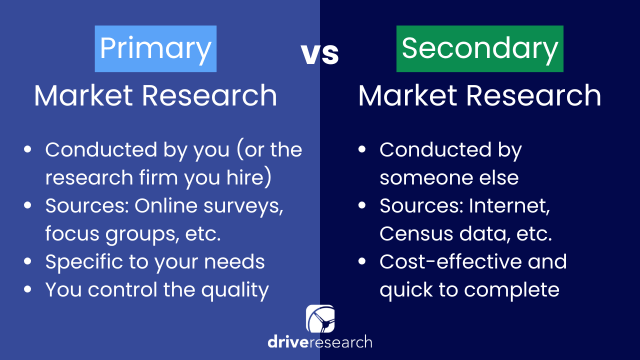
Organizations, brands, and researchers are constantly seeking ways to collect and explore more data that helps them understand the vast array of subjects.
One invaluable tool at their disposal is secondary research also, known as desk research.
Essentially secondary research means it’s data and research collected by someone else. This includes analyzing data prepared by other industry experts or syndicated databases.
While primary research involves collecting data firsthand, secondary research harnesses the wealth of existing information already available. In this blog post, our market research company delves into the world of secondary research, exploring its definition, advantages, limitations, and practical applications.
What Is Secondary Research? (Our Definition)
Secondary research refers to the process of gathering and analyzing existing data and information that has been collected by a third party from other sources for a different purpose. In fact, this data can actually come from a variety of sources.
It involves the use of existing sources such as books, government stats, articles, reports, surveys, and databases to obtain insights and knowledge on a specific topic or research question.
This data can be accessed from various sources, including academic journals, government publications, market research reports, industry studies, and online databases.
Primary vs Secondary Research
When we conduct primary research, we’re collecting data firsthand by asking questions to the target audience directly. This can be through interviews, surveys, or focus groups. These methods let us get specific answers, making our findings accurate.
Primary research takes time, money, and effort. You plan and conduct the research ourselves. This gives control over the process, ensuring the data is relevant and reliable. Companies own their own data, which can be especially important in competitive industries.
Secondary research is different.
It uses already existing data. This might include articles, reports, or data from previous studies. We use and analyze this information to support our research goals.
Secondary research is quicker and often more affordable since the data is already there. However, it might be lacking the exact answers or data that is needed.
Which is better?
Both primary and secondary research have their strengths. Even we at Drive Research have used secondary research in the past and it has helped companies that work with us.
Secondary helps identify gaps that need further exploration. Then, we conduct primary research to dive deeper into those areas, combining both methods for a thorough investigation.

How To Conduct Secondary Research
A secondary search can prove to be valuable in several market research settings. A project might look something like this:
Step 1. Identify Goals and Define The Answers Wanted
You’ll want to ask: what is it that you want to achieve with this project/research ?
Let’s say the goal of a research study is to understand customer satisfaction with the laundry detergent Tide. This is a common research goal and one that can be answered with data.
Step 2. Find and Collect Existing Data With Secondary Research
Secondary research can be utilized to gather data on average laundry detergent usage in the U.S., possibly even the number of individuals who use Tide.
Are there any organizations, companies, or statistics that already exist and can answer the questions?
In our case of tide customer satisfaction, there might be little data available from third parties but it isn’t impossible. In fact, there is this report from Kimola that showcases overall customer’s and their overall satisfaction with the tide liquid laundry detergent product.
This is a great example and for the project, we would want to accumulate as many similar reports or studies as possible.
Step 3. Combine The Data Sets and Analyze
This is the part where you’d want to put everything together. Combine all data sets as best as possible in order to have collective thoughts on the matter. If the data can’t mesh well together, you might have to analyze them separately.
The last part of the process is analyzing everything from a market research perspective. What does the data show? Does the data make sense? Does it help you reach your initial goal?
If it does, you’ve found a successful secondary market research project. If not, you may have to conduct a primary or custom market research project in order to fill in the gaps.
It’s what a lot clients that come to us experience, there just isn’t enough data to answer the specific questions they have about their brand/business.
How to Find and Use Secondary Research
Conducting secondary research may seem easier than primary research, but sometimes it can feel like you are trying to find a needle in a haystack.
Also, the time it takes to compile all of the information needed can take just as long as collecting data through primary research, but there are some important sources that can be used to start your search off strong!
Paid versus free to access? Scholarly papers versus opinion editorials? Print versus online?
It is likely a secondary search may be some combination of all of these. The needs of a project will determine where the search ultimately leads.
Sources to consider using for secondary research include:
- Census.gov/data
- Demographics Now/eSite analytics
- Nielsen
- Business journals
- News articles
- Company websites
- Published research reports
- Online conversations
There are several secondary research vendors and data available for a market research firm.
Some of the more popular 3rd party data sources include Census data or Nielsen data.
Benefits of Secondary Research
Primary research such as online surveys and focus groups are great because it’s the data is timely/the most up to date and it can be customized to the unique needs of a research project.
However, the fatal flaw of primary research is the inability to accurately measure previous habits to add context to the primary data collected.
Secondary research means spending time collecting and analyzing previously collected data/information.
Again, while it can take some time to collect, the information can be extremely valuable to help make decisions or even use as a benchmark to help add context to primary data being collected.
Benefits of secondary data collection include:
- Vast amounts of data from a variety of sources
- Ability to create insights from previous research
- Typically less expensive than primary research
- Collecting secondary data through a third party ensures an unbiased interpretation of the data
- Adds context to primary research
If you’re looking to conduct market research on a budget, I recommend reading What is the Most Cost-Effective Market Research Methodology?
Limitations of Secondary Research
We do face challenges when working with secondary research data.
- One major issue is that the data can be outdated. Even when sources are updated regularly, there can be gaps between these updates. This means the data might not be current, especially in fast-moving markets.
- Verification and interpretation is another big task. When using data from one source, we must analyze and vet it combined with or against other data sets to confirm its accuracy.
- Little control of the methodology and approach. Since we didn’t collect the data ourselves, we have no control over the research methods used. This lack of involvement can lead to issues if the data collection process was flawed.
- Secondary data isn’t exclusive. Many researchers can access the same data sets, leading to a lack of uniqueness in the findings. Those looking for exclusive insights and results might struggle with this limitation.
Examples of Secondary Research
1. Choosing a location
An example of secondary research could be analyzing 15 different designated market areas (DMAs) or metro areas.
The 15 markets would be pre-determined by the client. Various paid syndicated data sources and publicly available information would be used to source data.
Topics for the secondary research include:
- Employment capacity: Using data from the U.S. Census and state resources
- Occupational supply & demand: Leveraging Bureau of Labor statistics
- Political factors: Articles and information posted by state and local sources
- Competitive data: Competitor websites, marketing, media kits, and pricing information
- Other(s): Up to 3 other factors to be reviewed in the scope
Each indicator will be weighted in terms of importance. The matrix will use those weights and create a high-level scoring or rating for each factor and market.
The final deliverable for this research is the creation of a comprehensive Excel database of data and information for each of the indicators.
2. Understanding target demographics
Here is another example of conducting secondary search.
Let’s say you want to learn about the demographics of construction workers in the U.S. You might begin with an online search of these keywords.
One of the results could be a recent research study on the profile of construction workers. Once you can verify the source is reliable, this information could be the ticket to answering your questions.
Data such as gender, ethnicity, income, and language spoken at home is now hypothetically at your disposal.
An investigative report on the New York Times could give you equally valuable information from that initial online search.
Additionally, places like Census.gov, business journals, news articles, company websites, and more related are great places to find such info.
FAQ About Secondary Research
1. What is secondary research and the purpose?
The goal of secondary research is to examine the data collected from prior studies and apply it where it makes sense in the context.
2. How do you identify secondary research?
Secondary sources can be found in books, government sites, research journals, business websites, or other Internet resources.
Most of the time secondary research refers to published material, rather than supplementary material like bibliographies, encyclopedias, handbooks, and so forth.
3.What is considered a secondary study?
Secondary research is a method that involves using third party pre-existing data. Data is combined and summarized based on goals and objectives from other sources to assist with, support, or complete research goals.
Contact Our Full-Service Market Research Firm
Drive Research is a national market research company specializing in both primary and secondary research methods. Our team of certified professionals can recommend the best approach for meeting your unique project objectives, goals, timeline, and budget.
To learn more about our services, contact Drive Research today.



